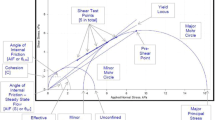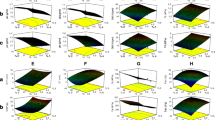Abstract
Purpose
Although the mechanical properties of paracetamol and MCC are extensively described in literature, there still is a need for a better understanding of the material properties impacting them. Thus, this study systematically analyzed material properties of paracetamol-MCC blends to elucidate their influence on the mechanical tablet properties in roller compaction and direct compression with special focus on surface properties.
Methods
Multiple material characteristics of binary mixtures of paracetamol and MCC with varying drug loads were analyzed, with particular emphasis on specific surface area and surface energy. Subsequently, mechanical tablet properties of the materials in direct compression and after roller compaction were examined.
Results
It was demonstrated that the impact of the initial material properties on mechanical tablet properties prevailed over the impact of processing route for paracetamol-MCC blends, underlining the importance of material characterization for tabletability of oral solid dosage forms. By applying bivariate as well as multivariate analysis, key material properties influencing the tabletability of paracetamol, MCC and its mixtures such as surface area, surface energy, effective angle of internal friction and density descriptors were identified.
Conclusions
This study highlighted the importance of comprehensive assessment of different material characteristics leading to a deeper understanding of underlying factors impacting mechanical tablet properties in direct compression and after roller compaction by the example of paracetamol-MCC mixtures with varying drug loads. Furthermore, it was shown that multivariate analysis could be a valuable extension to common bivariate analysis to reveal underlying correlations of material properties.
Graphical Abstract








Similar content being viewed by others
Data Availability
All data supporting the findings of this study are available within the paper and its Supplementary Material A and B.
References
Leane M, Pitt K, Reynolds G, Anwar J, Charlton S, Crean A, et al. A proposal for a drug product Manufacturing Classification System (MCS) for oral solid dosage forms. Pharm Dev Technol. 2015;20:12–21.
Barjat H, Checkley S, Chitu T, Dawson N, Farshchi A, Ferreira A, et al. Demonstration of the Feasibility of Predicting the Flow of Pharmaceutically Relevant Powders from Particle and Bulk Physical Properties. J Pharm Innov. 2021;16:181–96.
Wilms A, Kleinebudde P. Towards better understanding of the influence of process parameters in roll compaction / dry granulation on throughput, ribbon microhardness and granule failure load. Int J Pharm X. 2020;2(November):100059. https://doi.org/10.1016/j.ijpx.2020.100059.
Razavi SM, Scicolone J, Snee RD, Kumar A, Bertels J, Cappuyns P, et al. Prediction of tablet weight variability in continuous manufacturing. Int J Pharm. 2020;575:118727. https://doi.org/10.1016/j.ijpharm.2019.118727.
Van Snick B, Holman J, Vanhoorne V, Kumar A, De Beer T, Remon JP, et al. Development of a continuous direct compression platform for low-dose drug products. Int J Pharm. 2017;529(1–2):329–46. https://doi.org/10.1016/j.ijpharm.2017.07.003.
Jeon I, Betz G. Roll compaction as a dry granulation method for paracetamol. J Drug Deliv Sci Technol. 2011;21(3):257–62. https://doi.org/10.1016/S1773-2247(11)50035-8.
Tay JYS, Han QE, Liew CV, Sia Heng PW. Investigation on the effect of roller compaction on paracetamol. Pharm Dev Technol. 2020;25(1):100–6. https://doi.org/10.1080/10837450.2019.1676783.
Paul S, Sun CC. Gaining insight into tablet capping tendency from compaction simulation. Int J Pharm. 2017;524(1–2):111–20. https://doi.org/10.1016/j.ijpharm.2017.03.073.
Mangal S, Meiser F, Tan G, Gengenbach T, DA Morton V, Larson I. Applying surface energy derived cohesive – adhesive balance model in predicting the mixing, flow and compaction behaviour of interactive mixtures. Eur J Pharm Biopharm. 2016;104:110–6. https://doi.org/10.1016/j.ejpb.2016.04.021.
Wünsch I, Finke JH, John E, Juhnke M, Kwade A. Influence of the drug deformation behaviour on the predictability of compressibility and compactibility of binary mixtures. Int J Pharm. 2022;122117. https://doi.org/10.1016/j.ijpharm.2022.122117.
Sun CC. Decoding powder tabletability: Roles of particle adhesion and plasticity. J Adhes Sci Technol. 2011;25(4–5):483–99.
Fichtner F, Mahlin D, Welch K, Gaisford S, Alderborn G. Effect of Surface Energy on Powder Compactibility. Pharm Res. 2008;25(12):2750–9.
El Gindy NA, Samaha MW. Tensile strength of some pharmaceutical compacts and their relation to surface free energy. Int J Pharm. 1983;3:35–46.
Jenike AW. Storage and flow of solids. Bull No123 Utah Eng Exp Stn. 1964;53(26):1–198.
Brunauer S, Emmett PH, Teller E. Adsorption of Gases in Multimolecular Layers. J Am Chem Soc. 1938;60(2):309–19.
Thielmann F, Burnett DJ, Heng JYY. Determination of the Surface Energy Distributions of Different Processed Lactose Determination of the Surface Energy Distributions. Drug Dev Ind Pharm. 2007;33(11):1240–53. https://doi.org/10.1080/03639040701378035.
Fowkes FM. Attractive Forces at Interfaces. Ind Eng Chem. 1964;56(12):40–52.
Dorris GM, Gray DG. Adsorption of n-alkanes at zero surface coverage on cellulose paper and wood fibers. J Colloid Interface Sci. 1980;77(2):353–62.
Dong S, Brendlé M, Donnet JB. Study of solid surface polarity by inverse gas chromatography at infinite dilution. Chromatographia. 1989;28(9–10):469–72.
Della Volpe C, Siboni S. Some reflections on acid-base solid surface free energy theories. J Colloid Interface Sci. 1997;195(1):121–36.
Della Volpe C, Siboni S. Acid – base surface free energies of solids and the definition of scales in the Good – van Oss – Chaudhury theory. J Adhes Sci Technol. 2000;14(2):235–72.
Reutenauer S. Reproducibility of the dispersive component of surface energy measured by inverse gas chromatography - part I. Surface Measurement Systems Ltd., technical note 801; 2002.
Fell JT, Newton JM. Determination of Tablet Strength by the Diametral-Compression Test. J Pharm Sci. 1970;59(5):688–91. https://doi.org/10.1002/jps.2600590523.
Celik M, Marshall K. Use of a compaction simulator system in tabletting research. Drug Dev Ind Pharm. 1989;15(5):759–800. Available from: https://www.academia.edu/41300485. Accessed 29 Oct 2021.
Joiris E, Di Martino P, Berneron C, Guyot-Hermann A-M, Guyot J-C. Compression Behavior of Orthorombic Paracetamol. Pharm Res. 1998;15(7):1122–30.
Herting MG, Kleinebudde P. Studies on the reduction of tensile strength of tablets after roll compaction / dry granulation. Eur J Pharm Sci. 2008;70:372–9.
Sunkersett MR, Grimsey IM, Doughty SW, Osborn JC, York P, Rowe RC. The changes in surface energetics with relative humidity of carbamazepine and paracetamol as measured by inverse gas chromatography. Eur J Pharm Sci. 2001;13:219–25.
Prasad KVR, Sheen DB, Sherwood JN. Fracture property studies of paracetamol single crystals using microindentation techniques. Pharm Res. 2001;18(6):867–72.
Mullarney MP, Hancock BC. Improving the Prediction of Exceptionally Poor Tableting Performance : An Investigation into Hiestand ’ s ‘“ Special Case”.’ J Pharm Sci. 2004;93(8):2017–21.
Pitt KG, Heasley MG. Determination of the tensile strength of elongated tablets. Powder Technol. 2013;238:169–75. https://doi.org/10.1016/j.powtec.2011.12.060.
Sun CC, Kleinebudde P. Mini review: Mechanisms to the loss of tabletability by dry granulation. Eur J Pharm Biopharm. 2016;106:9–14. https://doi.org/10.1016/j.ejpb.2016.04.003.
Skelbæk-Pedersen AL, Vilhelmsen TK, Rantanen J, Kleinebudde P. The relevance of granule fragmentation on reduced tabletability of granules from ductile or brittle materials produced by roll compaction/dry granulation. Int J Pharm. 2020;2021(592):120035. https://doi.org/10.1016/j.ijpharm.2020.120035.
Keizer HL, Kleinebudde P. Elastic recovery in roll compaction simulation. Int J Pharm. 2020;573:118810. https://doi.org/10.1016/j.ijpharm.2019.118810.
Nesarikar VV, Patel C, Early W, Vatsaraj N, Sprockel O, Jerzweski R. Roller compaction process development and scale up using Johanson model calibrated with instrumented roll data. Int J Pharm. 2012;436(1–2):486–507. https://doi.org/10.1016/j.ijpharm.2012.06.027.
Herting MG, Kleinebudde P. Roll compaction / dry granulation : Effect of raw material particle size on granule and tablet properties. Int J Pharm. 2007;338:110–8.
Csordas K, Wiedey R, Kleinebudde P. Impact of roll compaction design, process parameters, and material deformation behaviour on ribbon relative density. Drug Dev Ind Pharm. 2018;44(8):1295–306. https://doi.org/10.1080/03639045.2018.1446444.
Johansson B, Alderborn G. The effect of shape and porosity on the compression behaviour and tablet forming ability of granular materials formed from microcrystalline cellulose. Eur J Pharm Biopharm. 2001;52:347–57.
Nordström J, Alderborn G. Degree of compression as a potential process control tool of tablet tensile strength. Pharm Dev Technol. 2011;16(6):599–608.
Acknowledgements
The authors gratefully acknowledge Axel Becker and Anke Marx for providing analytical support in conducting the inverse gas chromatography measurements and the scientific discussion.
Funding
No funding was received for conducting this study.
Author information
Authors and Affiliations
Contributions
Lena Mareczek: Conceptualization, Investigation, Formal analysis, Writing – original draft. Carolin Riehl: Conceptualization, Supervision, Writing – review & editing. Meike Harms: Software, Writing – review & editing. Stephan Reichl: Conceptualization, Supervision, Writing – review & editing.
Corresponding author
Ethics declarations
Conflict of Interest
The authors have no financial or proprietary interests in any material discussed in this article.
Additional information
Publisher's Note
Springer Nature remains neutral with regard to jurisdictional claims in published maps and institutional affiliations.
Supplementary Information
Below is the link to the electronic supplementary material.
Rights and permissions
Springer Nature or its licensor (e.g. a society or other partner) holds exclusive rights to this article under a publishing agreement with the author(s) or other rightsholder(s); author self-archiving of the accepted manuscript version of this article is solely governed by the terms of such publishing agreement and applicable law.
About this article
Cite this article
Mareczek, L., Riehl, C., Harms, M. et al. Elucidating the Impact of Material Properties on Tablet Manufacturability for Binary Paracetamol Blends. Pharm Res 41, 185–197 (2024). https://doi.org/10.1007/s11095-023-03626-6
Received:
Accepted:
Published:
Issue Date:
DOI: https://doi.org/10.1007/s11095-023-03626-6




